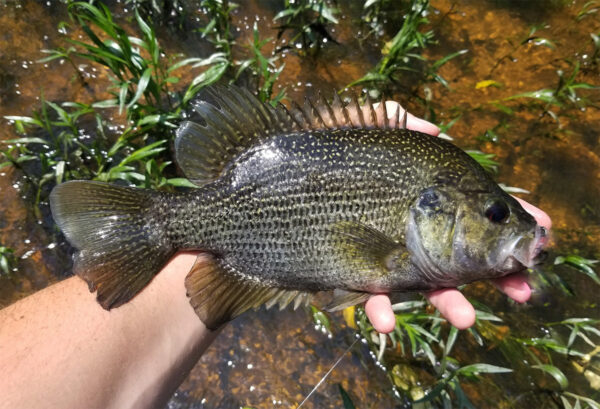A quality Roanoke Bass being released.
DWR biologists examine a juvenile Roanoke Bass during a fisheries assessment. Photo by ©Maddie Cogar - DWR
Fact File
Scientific Name: Ambloplites cavifrons
Classification: Fish, Order Perciformes, Family Centrarchidae
Conservation Status:
- Species of Greatest Conservation Need-Tier 1a on the Virginia Wildlife Action Plan
Size: Can obtain lengths of over 12 inches
Life Span: Unknown
Identifying Characteristics

- Largest species of the Ambloplites genus
- Anal fin margin is not darkened
- Rock Bass have a dark margin
- Robust body with a large head
- Generally olive-brown in color, darker mottling along the dorsum (back)
Diet
Roanoke Bass consume terrestrial insects, aquatic macroinvertebrates, crustaceans, and other fish.
Distribution
The Roanoke Bass is endemic to the Roanoke and Chowan River watersheds in southern Virginia.

Habitat
Roanoke Bass thrive in creeks and small rivers that have an abundance of clean flowing water and rocky substrates. Their populations are sensitive to sedimentation.
Last updated: January 13, 2025
The Virginia Department of Wildlife Resources Species Profile Database serves as a repository of information for Virginia’s fish and wildlife species. The database is managed and curated by the Wildlife Information and Environmental Services (WIES) program. Species profile data, distribution information, and photography is generated by the Virginia Department of Wildlife Resources, State and Federal agencies, Collection Permittees, and other trusted partners. This product is not suitable for legal, engineering, or surveying use. The Virginia Department of Wildlife Resources does not accept responsibility for any missing data, inaccuracies, or other errors which may exist. In accordance with the terms of service for this product, you agree to this disclaimer.

